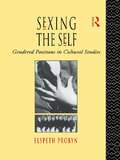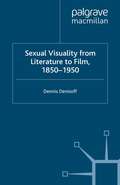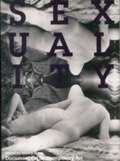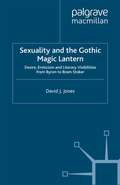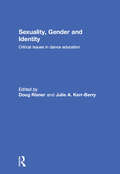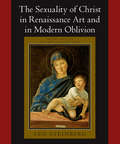- Table View
- List View
Sex, Symbolists and the Greek Body (Bloomsbury Studies in Classical Reception)
by Richard WarrenThis book explores Symbolist artists' fascination with ancient Greek art and myth, and how the erotic played a major role in this. For a brief period at the end of the 19th century the Symbolist movement inspired artists to turn inwards to the unconscious mind, endeavouring to unveil the secrets of human nature through their symbolic art. But above all their greatest interest, and fear, was man (and woman's) sexuality. Building upon the traditions of Academic neoclassicism, but fired with a new zeal, they turned back to Greek art and myth for inspiration. That classical legacy was once again a vehicle for artists to express their dreams, ideas and revelries. And so too their anxieties. For at times the frightening spectre of the sexual unconscious drove them to a new and innovative engagement with antiquity, including in ways never before tried in the history of the classical tradition. The unnerving sirens of Gustave Moreau, unearthly heroines of Odilon Redon, or leering fauns of Felicien Rops all played their role, among others, in this novel and unprecedented chapter in that tradition. This book shows how in their painting, drawing and sculpture the Symbolists re-invented Greek statuary and transposed it to new and unwonted contexts, as the imaginary inner worlds of artists were mapped onto the landscapes of Greek myth. It shows how they made of the Greek body, whether female, male, androgyne or sexual other, at once an object of beauty, desire, fear, and - at times - of horror.
Sex, Symbolists and the Greek Body (Bloomsbury Studies in Classical Reception)
by Richard WarrenThis book explores Symbolist artists' fascination with ancient Greek art and myth, and how the erotic played a major role in this. For a brief period at the end of the 19th century the Symbolist movement inspired artists to turn inwards to the unconscious mind, endeavouring to unveil the secrets of human nature through their symbolic art. But above all their greatest interest, and fear, was man (and woman's) sexuality. Building upon the traditions of Academic neoclassicism, but fired with a new zeal, they turned back to Greek art and myth for inspiration. That classical legacy was once again a vehicle for artists to express their dreams, ideas and revelries. And so too their anxieties. For at times the frightening spectre of the sexual unconscious drove them to a new and innovative engagement with antiquity, including in ways never before tried in the history of the classical tradition. The unnerving sirens of Gustave Moreau, unearthly heroines of Odilon Redon, or leering fauns of Felicien Rops all played their role, among others, in this novel and unprecedented chapter in that tradition. This book shows how in their painting, drawing and sculpture the Symbolists re-invented Greek statuary and transposed it to new and unwonted contexts, as the imaginary inner worlds of artists were mapped onto the landscapes of Greek myth. It shows how they made of the Greek body, whether female, male, androgyne or sexual other, at once an object of beauty, desire, fear, and - at times - of horror.
Sex & Violence, Death & Silence: Encounters with recent art
by Gordon Burn'The Pop artists were among the first to understand the desire of consumers to change their lives through the purchase of clean, manufactured commodities. YBA, on the other hand, was more interested in the dirt that accrues beneath the laminate surface of shiny things. Their special perception was that cheap language and cheap materials didn't have to equal cheap thinking. The trick was to tell it in a jaunty, unportentous, off-hand, unliterary - anti-literary - way. And then there were the drugs.'Spanning nearly 35 years, Sex & Violence, Death & Silence is a collection of the best of Gordon Burn's writing on art. Focusing on two principle generations - the Royal College pop art of Hockney and his contemporaries, and the YBA sensations of the 1990s - it explores how these artists rose to prominence with their friends and contemporaries, and what happened next.Burn's work is fast becoming a kind of chronicle. Its factuality always connects with the broader poetic rythms of cultural life. Displaying all his customary insight and empathy, his writing adds up to much more than a collection of pieces on art: superbly evocative and engaging, it offers a pathway through two of the most important and vibrant periods in recent art history, and is another compelling and ruminative look at our culture.
Sexing the Groove: Popular Music and Gender
by Sheila WhiteleySexing the Groove discusses these issues and many more, bringing together leading music and cultural theorists to explore the relationships between popular music, gender and sexuality. The contributors, who include Mavis Beayton, Stella Bruzzi, Sara Cohen, Sean Cubitt, Keith Negus and Will Straw, debate how popular music performers, subcultures, fans and texts construct and deconstruct `masculine' and `feminine' identities. Using a wide range of case studies, from Mick Jagger to Riot Grrrls, they demonstrate that there is nothing `natural', permanent or immovable about the regime of sexual difference which governs society and culture.Sexing the Groove also includes a comprehensive annotated bibliography for further reading and research into gender and popular music.
Sexing the Groove: Popular Music and Gender
by Sheila WhiteleySexing the Groove discusses these issues and many more, bringing together leading music and cultural theorists to explore the relationships between popular music, gender and sexuality. The contributors, who include Mavis Beayton, Stella Bruzzi, Sara Cohen, Sean Cubitt, Keith Negus and Will Straw, debate how popular music performers, subcultures, fans and texts construct and deconstruct `masculine' and `feminine' identities. Using a wide range of case studies, from Mick Jagger to Riot Grrrls, they demonstrate that there is nothing `natural', permanent or immovable about the regime of sexual difference which governs society and culture.Sexing the Groove also includes a comprehensive annotated bibliography for further reading and research into gender and popular music.
Sexing the Self: Gendered Positions in Cultural Studies
by Elspeth ProbynFaced with the seemingly enormous difficulty of representing `others', many theorists working in Cultural Studies have been turning to themselves as a way of speaking about the personal. In Sexing the Self Elspeth Probyn tackles this question of the sex of the self, an issue of vital importance to feminists and yet neglected by feminist theory until now, to suggest that there are ways of using our gendered selves in order to speak and theorize non-essential but embodied selves. Arguing for `feminisms with attitude', Sexing the Self ranges across a wide range of theoretical strands, drawing upon a body of literature from early Cultural Studies to Anglo-American feminist literary criticism, from `identity debates' to Foucault's `care of the self'.
Sexing the Self: Gendered Positions in Cultural Studies
by Elspeth ProbynFaced with the seemingly enormous difficulty of representing `others', many theorists working in Cultural Studies have been turning to themselves as a way of speaking about the personal. In Sexing the Self Elspeth Probyn tackles this question of the sex of the self, an issue of vital importance to feminists and yet neglected by feminist theory until now, to suggest that there are ways of using our gendered selves in order to speak and theorize non-essential but embodied selves. Arguing for `feminisms with attitude', Sexing the Self ranges across a wide range of theoretical strands, drawing upon a body of literature from early Cultural Studies to Anglo-American feminist literary criticism, from `identity debates' to Foucault's `care of the self'.
Sexual and Gender Diversity in the Muslim World: History, Law and Vernacular Knowledge
by Vanja HamzicDiscrimination on the grounds of sexual orientation or gender identity is forbidden in contemporary international human rights law, yet in many interpretations of Islamic law, this is seen to contradict the tenets of Islam. Vanja Hamzic here offers a path-breaking historical and anthropological analysis of the discourses on sexual and gender diversity in the Muslim world. The first of its kind, the book sheds new light on the understanding of diversity and resistance to hegemonic visions of the self in Muslim societies. Combining first-hand ethnographic accounts of Muslims in contemporary Pakistan – including the hijra community whose pluralist sexual and gender experience defy the disciplinary gaze of both international and state law – with new archival research, this book provides a unique mapping of Islamic jurisprudence, court practice and social developments in the Muslim world. Hamzic provides a comprehensive look at the ways in which sexually diverse and gender-variant Muslims are seen, and see themselves, within the context of the Islamic legal tradition.
Sexual Difference in European Cinema: The Curse of Enjoyment
by F. VighiWhat can film tell us about enjoyment and sexual difference? Can cinematic fiction be more Real than reality? Fabio Vighi looks at Jacques Lacan's theory of sexuality alongside some of the best-known works of European cinema, including films by Fellini, Truffaut, Antonioni and Bergman.
Sexual Diversity in Young Cuban Cinema
by Margaret G. FrohlichThis book explores how young Cuban filmmakers have expanded the range of sexual subjectivities on screen. It analyzes cine joven (films made by young directors) from the late 1980s to the early 2020s, film reviews, articles, and materials from the Cinematheque of Cuba's archive to illustrate the confluence of sexuality, cinema, and discourses of youth. While sexual and cinematic cultures have their own unique relation to the public sphere, state institutions, and transnational flows, this book explores tensions, debates, and expressions that unite them. In an investigation of how young filmmakers employ queer strategies of self-making to bring sexual diversity to the screen, Margaret G. Frohlich shows us how cine joven takes part in the socialization of power in Cuba.
Sexual Fluidity Among Millennial Women: Journeys Across a Shifting Sexual Landscape
by Alice CampbellDrawing on data collected from over 8,000 millennial women in Australia, this book proposes a new theory of women’s sexual identity that accounts for various sociocultural, historical, and interactional factors that inform women’s sexualities. The author provides a new model for understanding changes in sexual identity among women. Each new chapter focuses on a new aspect of their model: the contemporary context in which women are navigating sexual identities; sexual landscapes and the degree of heteronormativity that characterizes various sexual landscapes; experiences of sexual violence and their potential associations with the sexual trajectories of women; and the potential health and wellbeing implications of changes in sexual identity. Taken as a whole, this text challenges the essentialist framing of the “species” narrative in favor of a more nuanced and socially situated analysis of women’s sexualities throughout the life course.This monograph will be of interest to scholars and students in sociology, gender and sexuality studies, and psychology.
Sexual Minorities and Mental Health: Current Perspectives and New Directions
by Joanna Semlyen Poul RohlederThis edited book presents a comprehensive guide to the research, challenges and differing perspectives within mental health for sexual minority populations in the UK. Drawing on clinical, social, health and community psychology perspectives, it brings the urgency of this topic back to the fore, providing insight into some of ways we understand and make sense of the increased prevalence of poorer mental health in these populations. Using an intersectional approach, a broad range of experts from across academia and practice explore the specific threat and discrimination faced by sexual minorities and investigate the high prevalence of poor mental health, health risk behaviours and psychological distress in these groups. The volume also offers innovative insight as to ways in which the disparities experienced by sexual minorities may be addressed. Ideal for practitioners in mental health and sexuality, as well as psychologists, policy makers, and academics alike interested in mental health, sexuality, public health, psychotherapy, psychoanalysis, or counselling, this collection features wide array of qualitative and quantitative sources to describe the current state of the art with an interdisciplinary lens.
The Sexual Perspective: Homosexuality and Art in the Last 100 Years in the West
by Emmanuel CooperFirst published in 1986 to wide critical acclaim, The Sexual Perspective broke new ground by bringing together and discussing the painting, sculpture and photography of artists who were gay/lesbian/queer/bisexual. The lavishly illustrated new edition discusses the greater lesbian visibility within the visual arts and artist's responses to the AIDS epidemic. Emmanuel Cooper places the art in its artistic, social and legal contexts, making it a vital contribution to current debates about art, gender, identity and sexuality.
The Sexual Perspective: Homosexuality and Art in the Last 100 Years in the West
by Emmanuel CooperFirst published in 1986 to wide critical acclaim, The Sexual Perspective broke new ground by bringing together and discussing the painting, sculpture and photography of artists who were gay/lesbian/queer/bisexual. The lavishly illustrated new edition discusses the greater lesbian visibility within the visual arts and artist's responses to the AIDS epidemic. Emmanuel Cooper places the art in its artistic, social and legal contexts, making it a vital contribution to current debates about art, gender, identity and sexuality.
The Sexual Politics of Ballroom Dancing (Genders and Sexualities in the Social Sciences)
by Vicki HarmanThis book presents an engaging sociological investigation into how gender is negotiated and performed in ballroom and Latin dancing that draws on extensive ethnographic research, as well as the author’s own experience as a dancer. It explores the key factors underpinning the popularity of this leisure activity and highlights what this reveals more broadly about the nature of gender roles at the current time. The author begins with an overview of its rich social history and shifting class status, establishing the context within which contemporary masculinities and femininities in this community are explored. Real and imagined gendered traditions are examined across a range of dancer experiences that follows the trajectory of a typical learner: from finding a partner, attending lessons and forming networks, through to taking part in competitions. The analysis of these narratives creates a nuanced picture of a dance culture that is empowering, yet also highly consumerist and image-conscious; a highly ritualised set of practices that both reinstate and transgress gender roles. This innovative contribution to the feminist leisure literature will appeal to students and scholars of anthropology, dance, sport, gender, cultural and media studies.
Sexual Visuality From Literature To Film 1850-1950 (Palgrave Studies in Nineteenth-Century Writing and Culture)
by D. DenisoffA must-read for scholars of visuality, gender and sexuality. Denisoff's study explores the ways in which gothic, sensation and noir literature and cinema manipulated common notions of the visual in order to challenge sex- and gender-based assumptions that marginalized certain people and desires. Addressing authors and directors such as Mary Braddon, Wilkie Collins, Oscar Wilde, Vernon Lee, Virigina Woolf, Daphne du Maurier, Alfred Hitchcock, Otto Preminger and Fritz Lang, this study shows that what a society gets is often what it tries hardest not to see.
Sexuality: Documents Of Contemporary Art (Documents Of Contemporary Art Ser. (PDF)
by Amelia JonesIt has been argued, most notably in psychoanalytic and modernist art discourse, that the production of works of art is fundamentally driven by sexual desire. It has further been argued, particularly since the early 1970s, that sexual drives and desires also condition the distribution, display and reception of art. This anthology traces how and why this identification of art with sexual expression or repression arose and how the terms have shifted in tandem with artistic and theoretical debates, from the era of the rights movements to the present. Among the subjects it discusses are abjection and the ‘informe’, or formless; pornography and the obscene; the ‘performativity’ of gender and sexuality; and the role of sexuality in forging radical art or curatorial practices, in response to such issues as state-sponsored repression and anti-feminism in the broader social realm.
Sexuality and the Gothic Magic Lantern: Desire, Eroticism and Literary Visibilities from Byron to Bram Stoker (Palgrave Gothic)
by D. JonesThis fascinating study explores the multifarious erotic themes associated with the magic lantern shows, which proved the dominant visual medium of the West for 350 years, and analyses how the shows influenced the portrayals of sexuality in major works of Gothic fiction.
Sexuality, Gender and Identity: Critical Issues in Dance Education
by Doug Risner and Julie A. Kerr-BerrySexuality is a difficult topic for all educators. Dance teachers and educators are not immune to these educational challenges, especially given the large number of children, adolescents, and young adults who pursue dance study and performance. Most troubling is the lack of serious discourse in dance education and the development of educative strategies to promote healthy sexuality and empowered gender identities in proactive ways. This volume, focused on sexuality, gender, and identity in dance education, expands this developing area of study and investigates diverse perspectives from public schools, private sector dance studios and schools, as well as college and university dance programs. By openly bringing issues of sexuality and gender to the forefront of dance education and training, this book straightforwardly addresses critical challenges for engaged educators interested in age appropriate content, theme and costume; the hyper-sexualization of children and adolescents; sexual orientation and homophobia; the hidden curriculum of sexuality and gender; sexual identity; the impact of contemporary culture; and mass media, and sexual exploitation. The original research provides a frank discussion, highlighting practical applications and offering insights and recommendations for today’s educational environment in dance. This book was originally published as a special issue of the Journal of Dance Education.
Sexuality, Gender and Identity: Critical Issues in Dance Education
by Doug Risner Julie Kerr-BerrySexuality is a difficult topic for all educators. Dance teachers and educators are not immune to these educational challenges, especially given the large number of children, adolescents, and young adults who pursue dance study and performance. Most troubling is the lack of serious discourse in dance education and the development of educative strategies to promote healthy sexuality and empowered gender identities in proactive ways. This volume, focused on sexuality, gender, and identity in dance education, expands this developing area of study and investigates diverse perspectives from public schools, private sector dance studios and schools, as well as college and university dance programs. By openly bringing issues of sexuality and gender to the forefront of dance education and training, this book straightforwardly addresses critical challenges for engaged educators interested in age appropriate content, theme and costume; the hyper-sexualization of children and adolescents; sexual orientation and homophobia; the hidden curriculum of sexuality and gender; sexual identity; the impact of contemporary culture; and mass media, and sexual exploitation. The original research provides a frank discussion, highlighting practical applications and offering insights and recommendations for today’s educational environment in dance. This book was originally published as a special issue of the Journal of Dance Education.
The Sexuality of Christ in Renaissance Art and in Modern Oblivion
by Leo SteinbergOriginally published in 1983, Leo Steinberg's classic work has changed the viewing habits of a generation. After centuries of repression and censorship, the sexual component in thousands of revered icons of Christ is restored to visibility. Steinberg's evidence resides in the imagery of the overtly sexed Christ, in Infancy and again after death. Steinberg argues that the artists regarded the deliberate exposure of Christ's genitalia as an affirmation of kinship with the human condition. Christ's lifelong virginity, understood as potency under check, and the first offer of blood in the circumcision, both required acknowledgment of the genital organ. More than exercises in realism, these unabashed images underscore the crucial theological import of the Incarnation. This revised and greatly expanded edition not only adduces new visual evidence, but deepens the theological argument and engages the controversy aroused by the book's first publication.
The Sexuality of Christ in Renaissance Art and in Modern Oblivion
by Leo SteinbergOriginally published in 1983, Leo Steinberg's classic work has changed the viewing habits of a generation. After centuries of repression and censorship, the sexual component in thousands of revered icons of Christ is restored to visibility. Steinberg's evidence resides in the imagery of the overtly sexed Christ, in Infancy and again after death. Steinberg argues that the artists regarded the deliberate exposure of Christ's genitalia as an affirmation of kinship with the human condition. Christ's lifelong virginity, understood as potency under check, and the first offer of blood in the circumcision, both required acknowledgment of the genital organ. More than exercises in realism, these unabashed images underscore the crucial theological import of the Incarnation. This revised and greatly expanded edition not only adduces new visual evidence, but deepens the theological argument and engages the controversy aroused by the book's first publication.
The Sexuality of Christ in Renaissance Art and in Modern Oblivion
by Leo SteinbergOriginally published in 1983, Leo Steinberg's classic work has changed the viewing habits of a generation. After centuries of repression and censorship, the sexual component in thousands of revered icons of Christ is restored to visibility. Steinberg's evidence resides in the imagery of the overtly sexed Christ, in Infancy and again after death. Steinberg argues that the artists regarded the deliberate exposure of Christ's genitalia as an affirmation of kinship with the human condition. Christ's lifelong virginity, understood as potency under check, and the first offer of blood in the circumcision, both required acknowledgment of the genital organ. More than exercises in realism, these unabashed images underscore the crucial theological import of the Incarnation. This revised and greatly expanded edition not only adduces new visual evidence, but deepens the theological argument and engages the controversy aroused by the book's first publication.
The Sexuality of Christ in Renaissance Art and in Modern Oblivion
by Leo SteinbergOriginally published in 1983, Leo Steinberg's classic work has changed the viewing habits of a generation. After centuries of repression and censorship, the sexual component in thousands of revered icons of Christ is restored to visibility. Steinberg's evidence resides in the imagery of the overtly sexed Christ, in Infancy and again after death. Steinberg argues that the artists regarded the deliberate exposure of Christ's genitalia as an affirmation of kinship with the human condition. Christ's lifelong virginity, understood as potency under check, and the first offer of blood in the circumcision, both required acknowledgment of the genital organ. More than exercises in realism, these unabashed images underscore the crucial theological import of the Incarnation. This revised and greatly expanded edition not only adduces new visual evidence, but deepens the theological argument and engages the controversy aroused by the book's first publication.
Sexually Explicit Art, Feminist Theory, and Gender in the 1970s (Routledge Research in Gender and Art)
by Christian LiclairStructured around sexual desire as the central analytical category, this monograph systematically approaches a heterogeneous array of artworks to purposefully examine the entanglements of art, feminist theory, gender, and sexuality. This book considers the potential of sexually explicit art to challenge a socially constructed conception of sexuality as well as gender, and explores the sexually explicit as a means to (re-)claim agency for marginalized subjectivities and to emancipate desire from within the patriarchal and heteronormative system. In distinct case studies, the author focuses on works by four US-American artists – Robert Mapplethorpe, Joan Semmel, Betty Tompkins, and Tee A. Corinne – and situates them in relation to contemporaneous debates associated with the insurgent Sexual Liberation Movements of the 1970s. The book will be of interest to scholars working in art history, visual culture, and gender and sexuality studies.



